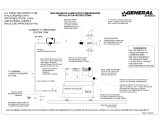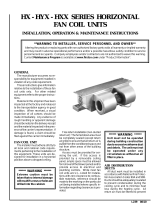
15
IOM - HRC Console Series
Open Loop - Ground Water Systems -
Shut off valves
should be included for ease of servicing. Boiler drains or
other valves should be “tee’d” into the lines to allow acid
flushing of the heat exchanger. Shut off valves should be
positioned to allow flow through the coax via the boiler
drains without allowing flow into the piping system.
P/T plugs should be used so that pressure drop and
temperature can be measured. Supply and return water
piping materials should be limited to copper, PE, or similar
material. PVC or CPVC should never be used as they are
incompatible with the POE oils used in HFC-410A products
and piping system failure and property damage may result.
Water quantity should be plentiful and of good quality.
Consult table 3 for water quality guidelines. The unit can
be ordered with either a copper or cupro-nickel water heat
exchanger. Consult Table 3 for recommendations. Copper
is recommended for closed loop systems and open
loop ground water systems that are not high in mineral
content or corrosiveness. In conditions anticipating heavy
scale formation or in brackish water, a cupro-nickel heat
exchanger is recommended. In ground water situations
where scaling could be heavy or where biological growth
such as iron bacteria will be present, an open loop system
is not recommended. Heat exchanger coils may over
time lose heat exchange capabilities due to build up of
mineral deposits. Heat exchangers must only be serviced
by a qualified technician, as acid and special pumping
equipment is required. Desuperheater coils can likewise
become scaled and possibly plugged. In areas with
extremely hard water, the owner should be informed that
the heat exchanger may require occasional acid flushing.
In some cases, the desuperheater option should not be
recommended due to hard water conditions and additional
maintenance required.
Water Quality Standards -
Table 3 should be consulted
for water quality requirements. Scaling potential should
be assessed using the pH/Calcium hardness method.
If the pH <7.5 and the calcium hardness is less than
100 ppm, scaling potential is low. If this method yields
numbers out of range of those listed, the Ryznar Stability
Ground-Water Heat Pump Applications
WARNING! Polyolester Oil, commonly known as POE oil, is
a synthetic oil used in many refrigeration systems including
those with HFC-410A refrigerant. POE oil, if it ever comes
in contact with PVC or CPVC piping, may cause failure of
the PVC/CPVC. PVC/CPVC piping should never be used
as supply or return water piping with water source heat
pump products containing HFC-410A as system failures and
property damage may result.
WARNING!
and Langelier Saturation indecies should be calculated.
Use the appropriate scaling surface temperature for the
application, 150°F [66°C] for direct use (well water/open
loop) and DHW (desuperheater); 90°F [32°F] for indirect
use. A monitoring plan should be implemented in these
probable scaling situations. Other water quality issues
such as iron fouling, corrosion prevention and erosion and
clogging should be referenced in Table 3.
Expansion Tank and Pump -
Use a closed, bladder-type
expansion tank to minimize mineral formation due to air
exposure. The expansion tank should be sized to provide at
least one minute continuous run time of the pump using its
drawdown capacity rating to prevent pump short cycling.
Discharge water from the unit is not contaminated in any
manner and can be disposed of in various ways, depending
on local building codes (e.g. recharge well, storm sewer,
drain field, adjacent stream or pond, etc.). Most local codes
forbid the use of sanitary sewer for disposal. Consult your
local building and zoning department to assure compliance
in your area.
Water Control Valve -
Always maintain water pressure in
the heat exchanger by placing the water control valve(s)
on the discharge line to prevent mineral precipitation
during the off-cycle. Pilot operated slow closing valves are
recommended to reduce water hammer. If water hammer
persists, a mini-expansion tank can be mounted on the
piping to help absorb the excess hammer shock. Insure
that the total ‘VA’ draw of the valve can be supplied by
the unit transformer. For instance, a slow closing valve
can draw up to 35VA. This can overload smaller 40 or
50 VA transformers depending on the other controls in
the circuit. A typical pilot operated solenoid valve draws
approximately 15VA..
Flow Regulation -
Flow regulation can be accomplished
by two methods. One method of flow regulation involves
simply adjusting the ball valve or water control valve on
the discharge line. Measure the pressure drop through the
unit heat exchanger, and determine flow rate. Since the
pressure is constantly varying, two pressure gauges may be
needed. Adjust the valve until the desired flow of 1.5 to 2
gpm per ton [2.0 to 2.6 l/m per kW] is achieved. A second
method of flow control requires a flow control device
mounted on the outlet of the water control valve. The
device is typically a brass fitting with an orifice of rubber
or plastic material that is designed to allow a specified
flow rate. On occasion, flow control devices may produce
velocity noise that can be reduced by applying some back
pressure from the ball valve located on the discharge line.
Slightly closing the valve will spread the pressure drop over
both devices, lessening the velocity noise.
Note: When
EWT is below 50°F [10°C], 2 gpm per ton (2.6 l/m per
kW) is required.





















